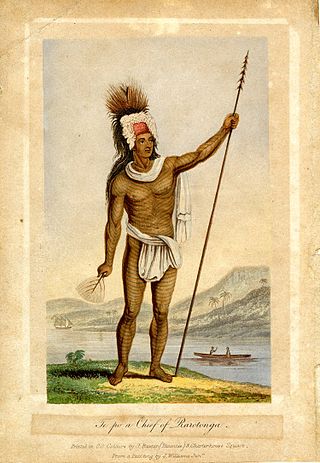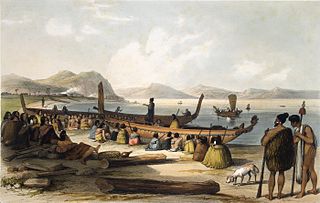Related Research Articles

The Cook Islands are named after Captain James Cook, who visited the islands in 1773 and 1777, although Spanish navigator Alvaro de Mendaña was the first European to reach the islands in 1595. The Cook Islands became aligned to the United Kingdom in 1890, largely because of the fear of British residents that France might occupy the islands as it already had Tahiti.

Aitutaki, also traditionally known as Araʻura and Utataki, is the second most-populated island in the Cook Islands, after Rarotonga. It is an "almost atoll", with fifteen islets in a lagoon adjacent to the main island. Total land area is 18.05 km2 (6.97 sq mi), and the lagoon has an area of between 50 and 74 km2. A major tourist destination, Aitutaki is the second most visited island of the Cook Islands archipelago.

Avaiki is one of the many names by which the peoples of Polynesia refer to their ancestral and spiritual homelands.

Rarotonga is the largest and most populous of the Cook Islands. The island is volcanic, with an area of 67.39 km2 (26.02 sq mi), and is home to almost 75% of the country's population, with 10,898 of a total population of 15,040. The Cook Islands' Parliament buildings and international airport are on Rarotonga. Rarotonga is a very popular tourist destination with many resorts, hotels and motels. The chief town, Avarua, on the north coast, is the capital of the Cook Islands.
In Polynesian mythology, Hawaiki is the original home of the Polynesians, before dispersal across Polynesia. It also features as the underworld in many Māori stories.

A marae, malaʻe, meʻae or malae is a communal or sacred place that serves religious and social purposes in Polynesian societies. In all these languages, the term also means cleared and free of weeds or trees. Marae generally consist of an area of cleared land roughly rectangular, bordered with stones or wooden posts perhaps with paepae (terraces) which were traditionally used for ceremonial purposes; and in some cases, a central stone ahu or a'u. In the Rapa Nui culture of Easter Island, the term ahu has become a synonym for the whole marae complex.
Hawaiʻiloa is a mythical Hawaiian fisherman and navigator who is said to have discovered the island of Hawaiʻi.

Waka are Māori watercraft, usually canoes ranging in size from small, unornamented canoes used for fishing and river travel to large, decorated war canoes up to 40 metres (130 ft) long.
Cook Islands Māori is an Eastern Polynesian language that is the official language of the Cook Islands. Cook Islands Māori is closely related to New Zealand Māori, but is a distinct language in its own right. Cook Islands Māori is simply called Māori when there is no need to disambiguate it from New Zealand Māori, but it is also known as Māori Kūki ʻĀirani or, controversially, Rarotongan. Many Cook Islanders also call it Te reo Ipukarea, literally "the language of the Ancestral Homeland".
Sir Thomas Robert Alexander Harries Davis was a Cook Islands statesman and medical researcher. He served as Prime Minister of the Cook Islands from 1978 to March 1983, and again from November 1983 to July 1987. He also worked as a medical officer, and as a medical researcher for the US Army and NASA. He was a founder of the Cook Islands Voyaging Society and constructed and voyaged in several replica vaka, including Tākitumu and Te Au o Tonga.

Manuae is an uninhabited atoll in the southern group of the Cook Islands, 100 kilometres south-east of Aitutaki. Manuae is not administratively part of Aitutaki, however, it is part of Arutanga-Reureu-Nikaupara Constituency on Aitutaki for electoral purposes only.

Polynesian navigation or Polynesian wayfinding was used for thousands of years to enable long voyages across thousands of kilometres of the open Pacific Ocean. Polynesians made contact with nearly every island within the vast Polynesian Triangle, using outrigger canoes or double-hulled canoes. The double-hulled canoes were two large hulls, equal in length, and lashed side by side. The space between the paralleled canoes allowed for storage of food, hunting materials, and nets when embarking on long voyages. Polynesian navigators used wayfinding techniques such as the navigation by the stars, and observations of birds, ocean swells, and wind patterns, and relied on a large body of knowledge from oral tradition. This island hopping was a solution against the scarcity of useful resources, such as food, wood, water, and available land, on the small islands in the Pacific Ocean. When an island’s required resources for human survival began to run low, the island's inhabitants used their maritime navigation skills and set sail for a new island full of possibilities. However, as an increasing number of islands in the South Pacific became occupied, and citizenship and national borders became of international importance, this was no longer possible. People thus became trapped on islands with the inability to support them.

Polynesia is a subregion of Oceania, made up of more than 1,000 islands scattered over the central and southern Pacific Ocean. The indigenous people who inhabit the islands of Polynesia are called Polynesians. They have many things in common, including language relatedness, cultural practices, and traditional beliefs. In centuries past, they had a strong shared tradition of sailing and using stars to navigate at night.
Dorice Reid, also known by the chiefly title Te Tika Mataiapo Dorice Reid, was a Cook Islander tourism official, businesswoman and judge. Reid enjoyed a long career in Cook Island business, politics and tourism from the 1970s until her death in 2011.

Pitcairn was a schooner built in 1890 for the Seventh-day Adventist Church for use in missionary work in the South Pacific. After six missionary voyages, the schooner was sold in 1900 for commercial use, and renamed Florence S. She was lost by stranding on the island of Mindoro, Philippine Islands, on 17 October 1912.

Marumaru Atua is a reconstruction of a vaka moana, a double-hulled Polynesian voyaging canoe. It was built in 2009 by the Okeanos Foundation for the Sea. In 2014, it was gifted to the Cook Islands Voyaging Society. It is used to teach polynesian navigation.

The Cook Islands Voyaging Society (CIVS) is a non-profit organisation in the Cook Islands dedicated to the promotion of Polynesian navigation, cultural ancestry, and environmental knowledge for future generations. It builds and sails replicas of traditional double-hulled voyaging canoes, undertaking voyages throughout Polynesia using traditional navigation techniques.

Gaualofa is a reconstruction of a va'a-tele, a double-hulled Polynesian voyaging canoe. It was built in 2009 by the Okeanos Foundation for the Sea. It was given to the Samoa Voyaging Society in 2012, on the occasion of Samoa's 50th anniversary of independence. It is used to teach polynesian navigation.
ʻAunofo Havea Funaki is the first woman from Tonga to become a licensed sea captain. The owner of a business that takes tourists to "swim with the whales", she has captained a traditional Polynesian canoe that sailed from the Pacific islands to the USA.

Faʻafaite is a reconstruction of a double-hulled Polynesian voyaging canoe. It was built in 2009 by the Okeanos Foundation for the Sea. It is operated by the Fa’afaite-Tahiti Voyaging Society and used to teach used to teach polynesian navigation.
References
- 1 2 "Te Au O Tonga". Cook Islands Voyaging Society. Archived from the original on 29 July 2020.
- ↑ "The Cook Islands Voyaging Society Strategic Plan 2018-2023" (PDF). Cook Islands Voyaging Society. p. 3. Retrieved 18 August 2020.
- 1 2 "Vaka Te Au O Tonga is back". Cook Islands News. 12 September 2012. Retrieved 13 November 2020.
- 1 2 3 4 5 6 7 "History of Voyaging". Cook Islands Voyaging Society. Archived from the original on 4 August 2020. Retrieved 18 August 2020.
- ↑ "NZ vaka modelled on Te Au O Tonga". Cook Islands News. 8 January 2018. Retrieved 13 November 2020.
- 1 2 "New chapter for much-loved vaka". Cook Islands News. 17 June 2014. Retrieved 13 November 2020.
- ↑ Quintina Naime (30 August 2015). "Anti-nuclear 'dream team' reunite". Loop. Retrieved 13 November 2020.
- ↑ CHRISTOPHE MARQUAND (1 September 1995). "Protest Vessels Ring Test Site, Awaiting Signs of First Blast". AP News. Retrieved 13 November 2020.
- ↑ "America's Cup underway with vibrant Pasifika flavour". Pacific Islands Monthly. Vol. 69, no. 11. 1 November 1999. p. 53. Retrieved 13 November 2020– via National Library of Australia.
- ↑ Nick Perry (30 June 2000). "Sailing in the wake of early navigators". New Zealand Herald. Retrieved 13 November 2020.
- ↑ Jon Tikivanotau M. Jonassen. "Cook Islands". Project Muse. Retrieved 13 November 2020.




